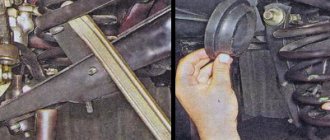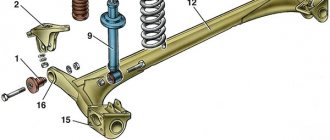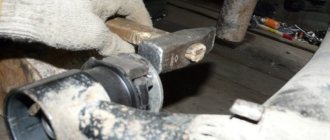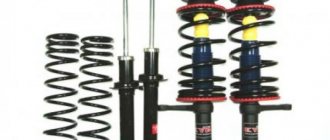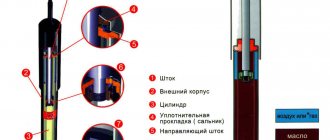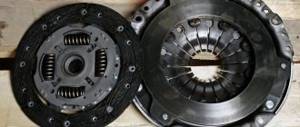Suspension parts on Russian roads very often experience heavy loads - any collision with a stone or falling into even a small hole becomes a real test for them. And they do not always pass through it without losses in the form of mechanical damage. This is especially true for shock absorbers and springs, which work together and often fail due to constant shaking. And if installing new struts is a prerequisite when repairing a car’s chassis, then whether it is necessary to change the springs when replacing shock absorbers is a difficult question for many drivers. To answer this, you must first understand the function they perform.
Function of shock absorbers and springs
These parts provide the car with improved handling along with a smooth ride. Moreover, springs are part of the suspension, which neutralize shocks and impacts when driving on poor-quality road surfaces. In fact, such an elastic element during its operation makes millions of compression-release cycles. In addition, if the car hits an obstacle, the wheel jumps up and the vehicle becomes uncontrollable. And in order to stabilize the situation as quickly as possible, the spring bounces back, simultaneously compressing so that the wheel falls to the ground as quickly as possible. However, after this part has been released, the vehicle continues to sway for a long time due to the released energy. The shock absorber, which has a rather complex design, is designed to quickly dampen these vibrations.
The modern automobile industry has long mastered the production of reliable springs of varying stiffness, so such parts rarely fail. But the racks are not as durable - they periodically need to be replaced. However, you need to understand that the answer to the question of whether it is necessary to change the springs along with shock absorbers depends on another important factor. After all, the suspension will only work well when these parts interact correctly with each other. For example, dampers hold the weight of the car, and struts control their movement, and if one of the elements of this combination does not work at full strength, then the other will have to take on an increased load. And if the springs sag due to metal fatigue or cracks in them, then the shock absorbers will fail much faster.
If you do not practice an aggressive driving style, the elastic elements of the suspension are able to fully perform their work even when coasting even at 300,000 km. The stand is considered the weak part in this combination, since depending on the type it contains a special gas or liquid. In addition, its design includes many sealing rings, which, under increased loads, lose their ability to ensure tightness.
What are shock absorbers and springs
The shock absorber and spring are an inseparable duet. Their main task is to make the car run as smoothly and under steering control as possible.
The spring, due to its elasticity, smoothes out the shaking and shocks that are inevitable when the car moves over uneven roads. When a car hits a pothole at any speed, the wheel jumps up. For a moment there is a loss of adhesion between the rubber and the road surface. The spring's job is to push the wheel down to the road as quickly as possible, because the "bounce" locks the steering.
But the spring doesn't just push down. It makes oscillatory movements, extinguishing the impact energy. The number of vibrations depends on the elasticity of the spring. The softer the steel from which the iron spiral was made, the stronger the compression and damping of impact energy.
The same forces that allow a basketball player to dribble the ball come into play. The wheel acts as a ball. If there were no shock absorbers, the car would constantly rock up and down on the springs when driving over uneven surfaces. The shock absorber dampens the oscillatory movements of the spring. In this case, the energy of body vibrations is converted into heat, causing the shock absorber body to heat up.
The damper is much more complex than the spring. And we all know that complex systems break down more often than simple ones. Therefore, the shock absorber wears out faster than the spring.
Causes and consequences of spring failure
Springs can lose their damping properties due to many factors. For example, if you heavily and regularly overload a car, then they will sag. Also, these parts may no longer fully perform their function due to the following reasons:
corrosion of metal;
mechanical wear;
driving on uneven road surfaces or roads full of rocks and other obstacles;
metal fatigue.
If the spring has lost at least part of its properties, the car holds much worse on the road and does not listen well to the steering wheel. The braking performance of the vehicle also decreases, and the shock absorbers wear out ahead of schedule.
When do springs need to be changed?
Whether the springs need to be changed when replacing shock absorbers depends on their condition. However, many auto mechanics argue: it is better not to save money and install a new assembly on the car, and to refuse reckless driving, which significantly reduces the service life of the suspension elements. However, ultimately, much depends on the circumstances of the repair - for example, struts in some cars can only be installed as an assembly with a spring - and the decision of the car owner himself. At the same time, there is a lot of visual evidence that the dampers definitely need to be replaced:
the height of the car has changed: to determine this, it is enough to compare the distance of all wheels to the wheel arches;
there are defects in the spring coils;
initial corrosion of the dampers indicates that it is better to replace them;
the inability of the spring to unbend to the required height after a compression cycle.
The only thing that cannot be noticed during a visual inspection of these parts is metal fatigue. Therefore, when repairing the suspension, it is still recommended not to install springs with traces of rust on new shock absorbers, otherwise sooner or later these parts will need to be replaced again.
Do I need to change springs when replacing a shock absorber?
In what cases is it necessary to change the springs along with the shock absorber?
All motorists know that our roads are very far from ideal. Most of the roads are simply covered with holes of various sizes and potholes. The car's suspension, in particular its springs and shock absorbers, suffers the most from this. When inspecting a car, car mechanics suggest changing everything together, but does it make sense to change the springs every time the shock absorber malfunctions?
Purpose of springs
Working together, the shock absorber and spring are responsible for the smooth ride and handling of the car. The spring softens shocks and vertical sway on uneven roads, and also helps restore traction when exiting.
The function of the spring is to absorb energy when the wheel hits the ground. This ability directly depends on its softness. Since the absorbed energy is consumed for a long time, and the car will continue to sway for a long time, then the work of the shock absorber begins. Its task is to dampen the swaying of the wheels and convert the swaying of the car body and its suspension into heat energy.
Do not forget that such a car part as a shock absorber is not very durable, and it must be checked often, and if there is damage, it must be urgently replaced. But here a natural question arises: “Is the entire system subject to replacement?” The operation of the entire car suspension will be harmonious only if the spring and shock absorber complement each other.
Reasons for replacing springs:
- external damage;
- rust;
- heavy loads when driving fast off-road;
- metal wear.
All of the above reasons negatively affect the condition of the car and can lead to breakdown. Of course, when replacing a shock absorber, you can also change the springs, but this is an additional expense. Despite the fact that the wear of metal cannot be determined by eye, this requires special equipment.
On the other hand, if you install a new shock absorber on a spring with rust, its service life will be significantly reduced. Many drivers, in order to reduce the cost of returning to a mechanic, ask to change this kit together.
It is necessary to replace the spring in two cases:
- failure;
- traces of rust or damage.
Shock absorbers and springs are replaced in pairs per axle. The thing is that the condition of the springs can be different, and this leads to an imbalance in the car suspension. After replacement, it is necessary to perform wheel alignment.
Is it possible to swap springs?
It would not be amiss to mention the frequent practice of many car owners: in an effort to save money, they swap the springs, that is, the dampers on the driver’s side are installed on the front passenger’s side. This is usually done if passengers are rarely transported. Moreover, such work is often carried out independently.
This method, of course, has a right to life, but it cannot be called reasonable and professional. After all, the spring on the driver's side is subject to heavy loads, and moving it to the right side of the car only temporarily solves the problem. In fact, the owner of the vehicle himself creates a weak point in it, because it has already been proven many times: like shock absorbers, springs need to be replaced only in pairs per axle. Ignoring this rule leads to an imbalance in the suspension - after all, the left and right springs have different operational properties. And this in many cases leads to a deterioration in the car’s controllability, as well as a decrease in ride comfort - after all, the dampers absorb impacts from the road surface much worse. Therefore, when repairing the suspension, you should always remember that an attempt to save a certain amount can lead to a significant decrease in the safety of the vehicle.
When it is necessary and not necessary to change the spring when replacing a shock absorber
Maximum suspension efficiency is achieved only with proper operation of the spring-shock absorber pair. These two elements complement each other and become useless separately.
The spring holds the weight of the car, and the shock absorber dampens swings and vibrations. Normally, the load is evenly distributed between these two suspension parts. But if one of the components fails, the second one has to work for two.
If the spring becomes very soft (for example, from old age), then the shock absorber takes on a huge load. In this mode, the damper will not work for a long time and will quickly break. A worn shock absorber no longer limits the movement of the spring. The car begins to “jump” on the road, making it almost impossible to control, which can lead to an accident.
The quality of the spring affects not only the smoothness of the ride. The adhesion force of the wheel to the road, the handling and braking qualities of the car depend on it.
Despite the simplicity of the device, the spring gradually loses its elasticity. There may be several reasons for this:
- natural wear and tear of the metal, which leads to its “fatigue”;
- damaging factors (stones bouncing off the road, friction, frequent full compression);
- Frequent transportation of heavy loads;
- quickly passing bumps on the road;
- metal corrosion accelerated by road salt and high humidity;
Do I always need to change the spring when replacing the shock absorber? This question can often be found on automotive forums. In almost any car service center, the mechanics will say that “yes, one does not change without the other.” Ideally, the spring can be replaced along with the shock absorber, but this is not a necessary condition.
If during a visual inspection you do not find obvious signs of corrosion and wear on the spring, then you can leave it. It would also be a good idea to check it for softness.
Please note: By leaving the old spring, the driver takes a small risk. Sometimes it is not so easy to visually determine the condition of a part. If the spring has lost its working qualities, then the replaced shock absorber will become unusable faster than it would happen with a new spring.
By replacing both components of the shock absorption system, the driver can be absolutely sure that it is in perfect condition.
There are situations when the spring must be changed:
- in case of breakage of any coil (springs break more often in the upper or lower part);
- in case of obvious corrosion processes;
- reducing the height between the wheel arches and the road surface (the spring sags);
- with a clear difference in height between the rear and front of the car;
In any other cases, the spring can be changed after one replacement of the shock absorber.
If you do not carry passengers, then when replacing the damper, the left and right springs should be swapped.
It is important to remember that shock absorbers and springs are always replaced in pairs on the same axis. This is done in order to avoid unbalanced suspension. And an imbalance in the suspension worsens the car's handling.
( 14 votes, average: 4.71 out of 5)
Engine decarbonization: instructions, recommendations, choice of decoking agent
What should I do if the rear window defogger does not work?


